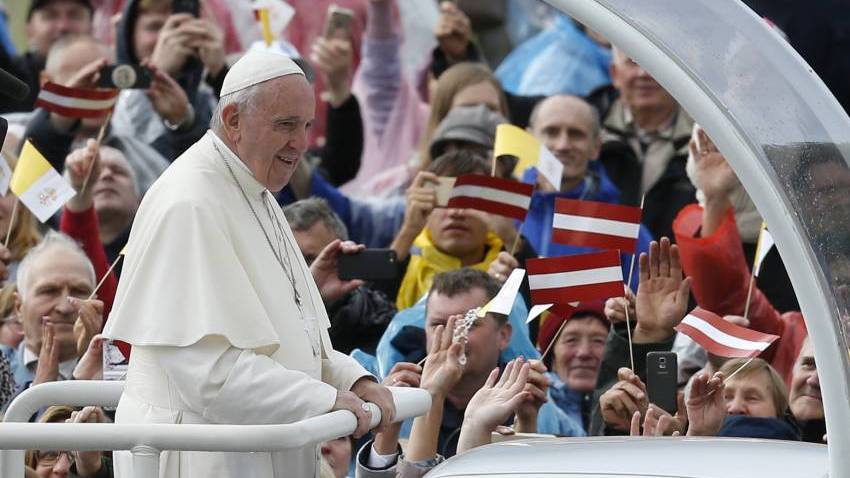

Homily of Pope Francis at Mass in Aglona, Latvia
Salt + Light Media
Monday, September 24, 2018

Pope Francis greets the crowd before celebrating Mass at the Shrine of the Mother of God in Aglona, Latvia. (CNS photo/Paul Haring)
Today, Pope Francis celebrated Mass at the Shrine of the Mother of God in Aglona, Latvia, an important local site of pilgrimage and home to a miraculous icon. Here is the full text of his homily:Truly, we can say that what Saint Luke tells us at the beginning of the book of the Acts of the Apostles is being repeated here today: we are joined together in prayer, in the company of Mary our Mother (cf. Acts 1:14). Today we make our own the theme of this Visit: “Show yourself as Mother!” Show us, Mother, where you continue to sing your Magnificat. Show us the places where your Son is crucified, that we may encounter your steady presence at the foot of the cross. The Gospel of John speaks of only two moments when the life of Jesus intersects with that of his Mother: the wedding feast at Cana (cf. Jn 2:1-12) and the account we have just read, where Mary stands beneath the cross (cf. Jn 19:25-27). Perhaps the Evangelist wants to show us the Mother of Jesus in these two apparently opposite situations in life – the joy of a wedding feast and sorrow at the death of a child. In her growing understanding of the mystery of the Word, Mary points us to the Good News that the Lord wants to share with us today. The first thing John mentions is that Mary “stands near the cross of Jesus”, close to her Son. She stood there, at the foot of the cross, with unwavering conviction, fearless and immovable. This is the main way that Mary shows herself – she stands near those who suffer, those from whom the world flees, including those who have been put on trial, condemned by all, deported. Nor is it that they are simply oppressed or exploited; they are completely “outside the system”, on the very fringes of society (cf. Evangelii Gaudium, 53). The Mother also stands close by them, steadfast beneath their cross of incomprehension and suffering. Mary also shows us how to “stand near” these situations; it demands more than simply passing by or making a quick visit, engaging in a kind of “tourism of solidarity”. Rather, it means that those in painful situations should feel us standing firmly at their side and on their side. All those discarded by society can experience the Mother who remains discreetly near them, for in their sufferings she sees the open wounds of her Son Jesus. She learned this at the foot of the cross. We too are called to “touch” the sufferings of others. Let us go out to meet our people, to console them and accompany them. Let us not be afraid to experience the power of tenderness, to get involved and let our lives become complicated for the sake of others (cf. ibid, 270). Like Mary, let us remain steadfast, our hearts at peace in God. Let us be ever ready to lift up the fallen, raise up the lowly and to help end all those situations of oppression that make people feel crucified themselves. Jesus asks Mary to receive the beloved disciple as her son. The text tells us that they stood together at the foot of the cross, but Jesus realized that this was not enough, that they had not yet fully “received” one another. For we can stand at the side of many people, even sharing the same home, neighbourhood or workplace; we can share the faith, contemplate and experience the same mysteries, but without embracing or actually “receiving” them with love. How many married couples could speak of lives lived next to one another, but not together; how many young people feel pained by the distance separating them from adults; how many elderly people feel tolerated, but not lovingly cared for and accepted. Certainly, when we open ourselves to others, we can get badly hurt. In political life, too, past conflicts between peoples can painfully come to the fore. Mary shows herself to be a woman open to forgiveness, to setting aside resentment and suspicion. She does not dwell on “what might have been”, had her Son’s friends, or the priests of his people and their rulers, acted differently. She does not give in to frustration or helplessness. Mary trusts Jesus and receives his disciple, for the relationships that heal us and free us are those that open us to encounter and fraternity with others, in whom we find God himself (cf. Evangelii Gaudium, 92). Bishop Sloskans, who rests here, after being arrested and sent away, wrote to his parents: “I beg you from the bottom of my heart: do not let vengeance or exasperation find a way into your hearts. If we permitted that to happen, we would not be true Christians, but fanatics”. Sometimes we see a return to ways of thinking that would have us be suspicious of others, or would show us with statistics that we would be better off, more prosperous and more secure just by ourselves. At those times, Mary and the disciples of these lands invite us to “receive” our brothers and sisters, to care for them, in a spirit of universal fraternity. Mary also shows herself as the woman who is willing to be received, who humbly lets herself become part of the disciple’s world. At the wedding feast, when the lack of wine might have left the celebration full of rituals but drained of love and joy, she commanded the servants to do what Jesus told them (cf. Jn 2:5). Now, as an obedient disciple, she is willing to accept, to go along with, the pace of someone younger than herself. Harmony is always difficult when we are different, when our differences of age, life experiences and circumstances lead us to feel, think and act in ways that, at first sight, seem opposed. When, in faith, we listen to the command to receive and be received, it becomes possible to build unity in diversity, for differences neither restrain nor divide us, but allow us to look more deeply and to see others in their most profound dignity, as sons and daughters of the same Father (cf. Evangelii Gaudium, 228). In this Eucharist, as in every Eucharist, we recall the day of Golgotha. From the foot of the cross, Mary invites us to rejoice that we have been received as her sons and daughters, even as her Son Jesus invites us to receive her into our own homes and to make her a part of our lives. Mary wants to give us her courage, so that we too can remain steadfast, and her humility, so that, like her, we can adapt to whatever life brings. In this, her Shrine, she begs that all of us may recommit ourselves to welcoming one another without discrimination. In this way, all in Latvia may know that we are willing to show preference to the poor, to raise up those who have fallen, and to receive others just as they come, just as they are.
Related Articles:
>>













